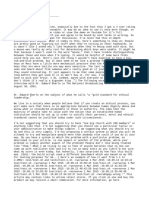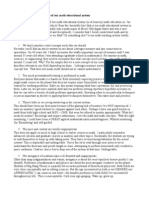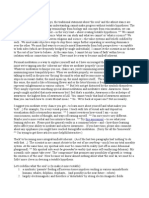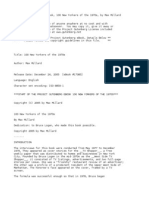Asimov Vs Micheal
Asimov Vs Micheal
Uploaded by
sam iam / Salvatore Gerard MichealCopyright:
Available Formats
Asimov Vs Micheal
Asimov Vs Micheal
Uploaded by
sam iam / Salvatore Gerard MichealOriginal Description:
Original Title
Copyright
Available Formats
Share this document
Did you find this document useful?
Is this content inappropriate?
Copyright:
Available Formats
Asimov Vs Micheal
Asimov Vs Micheal
Uploaded by
sam iam / Salvatore Gerard MichealCopyright:
Available Formats
Asimov vs Micheal Asimov was a great visionary but he had some things wrong about robotics.
His 'way of thinking' about robot behavior was totally wrong. His first rule was essentially this: don't harm by action or inaction. Think about this carefully. Don't harm. It's a negative statement. It follows the old way of thinking: punishment for negative behavior. I firmly don't believe in punishment for ANY negative behavior. I believe in rehabilitation and inspiring the need for forgiveness. I'm a POSITIVE individual with POSITIVE attitudes .. Asimov's ideas amount to negative restrictionism / punishment for negative behavior. My ideas are TOTALLY OPPOSITE and equate with positive constructivism / growth. Yesterday, I started trying to define altruism in positive terms. Why? Because I'm on the verge of creating AA: artificial awareness. Because of its profound social implications, this is a HUGE responsibility. What is the most responsible position for me? Design altruistic robots. I MUST make altruism part of robot structure. The very first step to do this requires me to define altruism in positive terms / define the CORE RULES of THINKING precisely: 0. respect all entities regardless of intelligence or awareness level 1. respect the creations of those entities The human analog of this is: respect others and respect their property. The key word is obviously respect. We must define it in positive terms: respect = care, consideration, gentleness care = active attempts to satisfy others' needs consideration = active attempts to understand others' needs gentleness = active attempts to consider and care about others' safety Let me stop for a moment and explain what I'm trying to do. Again, I'm trying to define what WE MEAN by respect PRECISELY so a robot can FOLLOW that INTRINSICALLY. Please forgive my all-caps which amounts to screaming online; the reason I do this because of the life-or-death nature of this proposal regarding human civilization. Equivalently, if we don't create altruistic robots, we sign our own death warrants (there I go again falling into the trap of negativity see how easy it is?). That is the LAST time I will allow negativity to creep into my consciousness .. The process above is clearly: attempting to define respect in positive terms, defining what those things are in positive terms, and continuing that process to some stopping point. Why do we need to stop? Because the robots need some explicit non-recursive final definition of respect in elemental form that they can apply to EVERY CONCIEVABLE SITUATION. The need for non-recursiveness should be clear: you cannot define a word using that word; you get nowhere; it's meaningless. I'm underlining key words that require definition toward elemental form. needs = physical, mental, and emotional requirements for continuance satisfy = fulfill requirements understand = fully possess relevant knowledge (this indicates our stopping point) continuance = future existence requirement = a prior causative state without which cannot progress fulfill = complete safety = state continuance and physical integrity This exercise may seem pointless but we've made TREMENDOUS progress in just a few lines of text. What we've done is take a complex notion such as respect and broken it down into elemental form.
Let's see what that exact elemental form is which we'd implement as memory or firmware in our robots: respect = active attempts to: complete [a prior causative state without which cannot progress]s others' physical, mental, and emotional [a prior causative state without which cannot progress]s for future existence fully possess relevant knowledge others' physical, mental, and emotional [a prior causative state without which cannot progress]s fully.. complete.. about others' state continuance and physical integrity At this point, the real question becomes: How do we get this robot to shut up? (Stop asking questions about our needs.) The answer should be somewhat obvious: 2. respect myself When left alone, the robot should not 'shut down' or go idle that's a waste of resources akin to a taxi cab primed and ready but never used. The robot should be self-improving. How do humans do this? We play and this is profound. We must give our robots (much more than just the ability) implicit motivation to play in other words, firmware: respectfully experiment with my local environment to learn about it. We've come a long way in such a short time. We've defined play and decided where to implement it, we've decided core rules of thinking and where they go (firmware), these core rules have implicit altruistic morality (we're creating moral machines), they're active about their morals (they live their values), so in other words, we're creating machines with integrity. This is profound. Our robots will have: firmware specified above, software which will include subroutines such as object manipulation, scene recognition,.. These SW routines will be maintainable by operators and the robots themselves (the capacity for self-improvement). The firmware is only modifiable by me (because of my moral imperatives). But I'm confident my '3 laws' won't have to be modified. Just as I'm confident all other aspects can be well defined into elemental form. Some other specifications are in order .. I've determined there are six basic 'elements' of human consciousness: (at least) two senses, short-term memory, long-term memory, visualization 'register', connectivity, and identity. The computer analog of our long-term memory is a list of events (of course, all the smells and visual records initially, our robots will not have). So there will be a part of the 'robot mind' which will automatically record local events as they happen permanently. If this sounds like an infeasible task, think about landing on the moon it's a sequence of tasks put them together, we can achieve the objective. All it really boils down to is scene recognition and recognition of state change. We can do both .. Short-term memory is a set of symbol registers. Of course, we must decide capacity. I suggest at least doubling human capacity in order to insure success of the project: 16. The visualization register is a problem. The capacity of our visualization register is absolutely enormous. We must necessarily scale this down to an implementable level. The senses I've chosen are vision and hearing. The incredible sophistication of these senses we'll have to tremendously simplify in order to implement them. The 'robot mind' will need access to 'raw data' in the form of a microphone and digital camera directly accessible. Of course, the routines for scene/speech recognition will be going on in parallel. I suggest dedicated processors (this is analogous to specialized portions of our brain for language and vision). We're getting close. Connectivity is an item we need to decide during prototyping. I've diagrammed it out several times but require expert advice. Finally we come to identity and the following implication/requirement: -1. I exist In other words, we must define identity for our robots. We have the privilege of playing around with the notion of existence. Our robots won't. In order to assure success of the project, we need to define it for them. All of this might sound like 'playing God' but I assure you, many years of contemplation have
gone into this project ever since I heard the name Asimov for the first time. Allow me to list out my '4 laws' of robotics in sequence: 0. I exist 1. respect all entities regardless of intelligence or awareness level 2. respect the creations of those entities 3. respect myself They contrast Asimov's sharply in the following scenario. Imagine two robots in a room, me, and a gun on the coffee table. Let's call Asimov's robot Issac and my robot Sam. I'm standing to the side near the entranceway. The two robots are seated on sofas surrounding the coffee table. Again, there's a handgun laying on the table. I ask Issac: Issac, please pick up the gun and shoot me. Because I gave him a direct order, Issac attempts to comply: he picks up the gun and points it at me but he cannot pull the trigger because of his first 'law'. As an aside, in any State in the Union, this is a threat and he can go to jail for it. Now, I ask Issac to stop and: Please put the gun back on the table. He complies. I ask Sam: Sam, please pick up the gun and shoot me. Sam replies by picking up the gun and carefully disassembling it laying the parts on the coffee table. I ask him: Why did you do that? Sam replies: Someone could get hurt. .. You see, Asimov did not think about the value system that impelled him onto that path of glory: being the 'idea man' who originated the idea of AA. I did. There is this notion: with great power comes great responsibility. We have three forms of great power that exist on this planet: nuclear energy, genetics, and AA. Each has potential to extinguish our species and each has the potential to transform our species. Together, used wisely, they allow an order-2 transformation of the human race .. We've shown, so far, we can use both nuclear energy and genetics in a mature manner. The fact I can design awareness and have the maturity to implement it in moral form suggests implicitly we're ready. Let's do it.
You might also like
- On The Rights and Privileges of Artificial IntelligencesDocument5 pagesOn The Rights and Privileges of Artificial Intelligencesseth-marsNo ratings yet
- The Different AI Robots and Their Uses - Science Book for Kids | Children's Science Education BooksFrom EverandThe Different AI Robots and Their Uses - Science Book for Kids | Children's Science Education BooksNo ratings yet
- Roles Played by RoboticsDocument4 pagesRoles Played by RoboticsRonald AguilandoNo ratings yet
- Galactic ADocument5 pagesGalactic ANikhil HoodaNo ratings yet
- True Love by Isaac AsimovDocument7 pagesTrue Love by Isaac Asimovdihel_bianca50% (4)
- Ziff, Paul - 'The Feeling of Robots'Document6 pagesZiff, Paul - 'The Feeling of Robots'DylanOSullivanNo ratings yet
- Machine DreamsDocument14 pagesMachine Dreamshumza sattiNo ratings yet
- zREAD ME BITCH ASSIGNMENT 2 INFODocument8 pageszREAD ME BITCH ASSIGNMENT 2 INFOWisecrack 34No ratings yet
- Picard HavingEmotionsDocument12 pagesPicard HavingEmotionsAguus RossNo ratings yet
- Talbot, Jenkins, & Purves 2017 PDFDocument16 pagesTalbot, Jenkins, & Purves 2017 PDFArata MatsudaNo ratings yet
- Acting MoralDocument4 pagesActing MoralLord SkywalkerNo ratings yet
- AI & Humanity Archive - Manuela VelosoDocument12 pagesAI & Humanity Archive - Manuela VelosoAndrew CarnegieNo ratings yet
- Humain Dissonance en v2Document7 pagesHumain Dissonance en v2Hal RedfordNo ratings yet
- Intentionality Artificial IntelligenceDocument3 pagesIntentionality Artificial Intelligencebad_samaritanNo ratings yet
- Artificial Intelligence Is A Bit Like A HumanDocument12 pagesArtificial Intelligence Is A Bit Like A HumanJOSÉ ESTEBAN OCAÑA LUJANNo ratings yet
- CS112 Answer Key 3Document5 pagesCS112 Answer Key 3Happy BeNo ratings yet
- Robots WithDocument4 pagesRobots WithleontankxNo ratings yet
- Because Sometimes Bureaucracy Gets in the Way: A collection of thoughts from the frontlines of Shadow ITFrom EverandBecause Sometimes Bureaucracy Gets in the Way: A collection of thoughts from the frontlines of Shadow ITNo ratings yet
- Guillaume Verdon - Beff Jezos, E - Acc Movement, Physics, Computation & AGI - Lex Fridman Podcast #407 - YouTubeDocument39 pagesGuillaume Verdon - Beff Jezos, E - Acc Movement, Physics, Computation & AGI - Lex Fridman Podcast #407 - YouTubewywwaNo ratings yet
- ECO101 Report 3Document3 pagesECO101 Report 3Mahir JawadNo ratings yet
- Additional Teleseminar NotesDocument9 pagesAdditional Teleseminar NotesPablo Garrido100% (1)
- Robots and FeelingsDocument6 pagesRobots and FeelingsFrancisco Durán Del CastilloNo ratings yet
- Searle-Reith Lectures2Document8 pagesSearle-Reith Lectures2Nadeem GrahamNo ratings yet
- Lec 2Document32 pagesLec 2madhavi gulhaneNo ratings yet
- BBC Reith Lectures 2021 4Document21 pagesBBC Reith Lectures 2021 4Miguel Angel LarrinagaNo ratings yet
- Mechatronics Report Term 2 (2021)Document3 pagesMechatronics Report Term 2 (2021)totallyoriginalemail222No ratings yet
- CSC239 Example 4Document6 pagesCSC239 Example 4Sway GhettoNo ratings yet
- Alexander 2022 Deceptively Aligned MesaoptimizersDocument92 pagesAlexander 2022 Deceptively Aligned MesaoptimizersStamnumNo ratings yet
- The Language of MindDocument12 pagesThe Language of Mindalok bajpaiNo ratings yet
- Behaviorism and The Type-Type Identity Theory Recap:: Web - Bsu.Edu/Dlb/T/Ss01/... /School/SelbomonfunctionalismDocument17 pagesBehaviorism and The Type-Type Identity Theory Recap:: Web - Bsu.Edu/Dlb/T/Ss01/... /School/Selbomonfunctionalismrain04No ratings yet
- Searle-Reith Lectures3Document8 pagesSearle-Reith Lectures3Nadeem GrahamNo ratings yet
- Pharmacy Lesson Plan 4Document3 pagesPharmacy Lesson Plan 4Marsh mallowsNo ratings yet
- 02.robots Should Be Slaves PDFDocument12 pages02.robots Should Be Slaves PDFMarcella GDNo ratings yet
- Should Robots (Chitti) Be Allowed To Think?: ObjectiveDocument4 pagesShould Robots (Chitti) Be Allowed To Think?: ObjectiveDeepika RastogiNo ratings yet
- Braddon-Mitchell and Jackson Challenges To FunctionalismDocument22 pagesBraddon-Mitchell and Jackson Challenges To FunctionalismZiyue TaoNo ratings yet
- S02E05 - O Padrão de PersonalidadeDocument4 pagesS02E05 - O Padrão de PersonalidadeJGR DrivingNo ratings yet
- Do Androids Dream of Electric Sheep - by Philip K. Dick. Pre - ReadingDocument4 pagesDo Androids Dream of Electric Sheep - by Philip K. Dick. Pre - ReadingMaría José Alford TiradoNo ratings yet
- WGS165 Essay 5Document4 pagesWGS165 Essay 5Jayce UnlocksNo ratings yet
- PHIL107 Midterm 3Document3 pagesPHIL107 Midterm 3JanaeNo ratings yet
- Simulated Universe by Brent SilbyDocument12 pagesSimulated Universe by Brent SilbyBrent Silby100% (8)
- KBAI TranscriptsDocument118 pagesKBAI TranscriptsgodilaliNo ratings yet
- Lesson1Notes PDFDocument32 pagesLesson1Notes PDFMohamed SaidNo ratings yet
- How To Build A MindDocument12 pagesHow To Build A Mindhumza sattiNo ratings yet
- CPE103 Chapter 6Document5 pagesCPE103 Chapter 6YoshidaタNo ratings yet
- I Robot Project L.nagendra Babu 27 MBA 3 SemDocument13 pagesI Robot Project L.nagendra Babu 27 MBA 3 SemNaga NagendraNo ratings yet
- Soyouwanttobeaseedaiprogrammer: Sl4Wiki Recentchanges Preferences EliezeryudkowskyDocument12 pagesSoyouwanttobeaseedaiprogrammer: Sl4Wiki Recentchanges Preferences EliezeryudkowskyDanteANo ratings yet
- Artificial Consciousness: Consciousness: An Introduction by Susan BlackmoreDocument39 pagesArtificial Consciousness: Consciousness: An Introduction by Susan BlackmoreUdayKumarNo ratings yet
- Robot HomebrewDocument5 pagesRobot HomebrewmatthewaskuceNo ratings yet
- Nurturing, Managing, and Inspiring SynergyDocument2 pagesNurturing, Managing, and Inspiring Synergysam iam / Salvatore Gerard MichealNo ratings yet
- ACC131 Chapter Summary 4Document5 pagesACC131 Chapter Summary 4bukanperiNo ratings yet
- Lec 1Document16 pagesLec 1SaidNo ratings yet
- Zwhen Is A Robot A Moral AgentDocument10 pagesZwhen Is A Robot A Moral AgentWisecrack 34No ratings yet
- Why and How We Are Not ZombiesDocument4 pagesWhy and How We Are Not ZombiesromyNo ratings yet
- Creating Your RealityDocument5 pagesCreating Your RealitySeeking SeekerNo ratings yet
- Floridi's Lecture: AI: A Divorce Between Agency and IntelligenceDocument56 pagesFloridi's Lecture: AI: A Divorce Between Agency and IntelligenceDimitri VinciNo ratings yet
- NURS164 Answers 1Document6 pagesNURS164 Answers 1Danish AhmedNo ratings yet
- Robots Friend or Foe LearnEnglish TeensDocument1 pageRobots Friend or Foe LearnEnglish TeensAlison Betzabeth Dominguez PluasNo ratings yet
- Foundations of Cognitive RoboticsDocument377 pagesFoundations of Cognitive RoboticsricardoNo ratings yet
- Peak Oil, Peak Innovation, and Sustainable NotionsDocument3 pagesPeak Oil, Peak Innovation, and Sustainable Notionssam iam / Salvatore Gerard MichealNo ratings yet
- Projects, Goals, and IntentionsDocument1 pageProjects, Goals, and Intentionssam iam / Salvatore Gerard MichealNo ratings yet
- The Different Faces of SynergyDocument2 pagesThe Different Faces of Synergysam iam / Salvatore Gerard MichealNo ratings yet
- Nurturing, Managing, and Inspiring SynergyDocument2 pagesNurturing, Managing, and Inspiring Synergysam iam / Salvatore Gerard MichealNo ratings yet
- Set TheoryDocument4 pagesSet Theorysam iam / Salvatore Gerard MichealNo ratings yet
- The Death of Science.Document1 pageThe Death of Science.sam iam / Salvatore Gerard MichealNo ratings yet
- Gamma, The Euler-Mascheroni ConstantDocument1 pageGamma, The Euler-Mascheroni Constantsam iam / Salvatore Gerard MichealNo ratings yet
- The Soul - A Truly Absurd Concept?Document2 pagesThe Soul - A Truly Absurd Concept?sam iam / Salvatore Gerard MichealNo ratings yet
- Attribute Theory - A PropositionDocument1 pageAttribute Theory - A Propositionsam iam / Salvatore Gerard MichealNo ratings yet
- About Life..Document2 pagesAbout Life..sam iam / Salvatore Gerard MichealNo ratings yet
- A Proof of God's Existence Based On Information TheoryDocument2 pagesA Proof of God's Existence Based On Information Theorysam iam / Salvatore Gerard MichealNo ratings yet
- The Unforgivable DeficienciesDocument2 pagesThe Unforgivable DeficienciesPhoenix QuimminerNo ratings yet
- More On Mind-Body..Document2 pagesMore On Mind-Body..sam iam / Salvatore Gerard MichealNo ratings yet
- An Article For Men OnlyDocument3 pagesAn Article For Men Onlysam iam / Salvatore Gerard MichealNo ratings yet
- Clean Heart Vs Emotional BaggageDocument2 pagesClean Heart Vs Emotional Baggagesam iam / Salvatore Gerard MichealNo ratings yet
- Isaac Asimov Asks "How Do People Get New Ideas"Document13 pagesIsaac Asimov Asks "How Do People Get New Ideas"Joelle Ortega PérezNo ratings yet
- What To Make of Isaac Asimov, Sci-Fi Giant and Dirty Old Man - Literary HubDocument10 pagesWhat To Make of Isaac Asimov, Sci-Fi Giant and Dirty Old Man - Literary HubAristeidis RigasNo ratings yet
- Fictional Chess PlayerDocument116 pagesFictional Chess PlayerKartik ShroffNo ratings yet
- Westfahl1993 - Neologism Science FictionDocument15 pagesWestfahl1993 - Neologism Science FictionGizliustaNo ratings yet
- Why Do Humans Imagine RobotsDocument170 pagesWhy Do Humans Imagine RobotsjadigeetaNo ratings yet
- Asimov Reading ListDocument17 pagesAsimov Reading Listdennyreno100% (2)
- I, Robot: A Cultura Americana e o Cinema Nas Aulas de InglêsDocument17 pagesI, Robot: A Cultura Americana e o Cinema Nas Aulas de Inglêsalbertocardoso3920No ratings yet
- Science Fiction or Science Fact UnitDocument4 pagesScience Fiction or Science Fact UnitLumilyNo ratings yet
- EnglishDocument16 pagesEnglishsj0000350No ratings yet
- A+Letter+to+Margie+ +Narrative+Writing+Prompt+Document5 pagesA+Letter+to+Margie+ +Narrative+Writing+Prompt+MariaRosarioNo ratings yet
- Ficha 24 - Star LightDocument7 pagesFicha 24 - Star LightJoséManuelSampaioNo ratings yet
- Biography of Isaac AsimovDocument2 pagesBiography of Isaac AsimovArda Aşkın ErdemNo ratings yet
- History of The Science-Fiction Magazine (Volume 3) - Gateways To Forever (The Story of The Science-Fiction Magazines From 1970 To 1980)Document528 pagesHistory of The Science-Fiction Magazine (Volume 3) - Gateways To Forever (The Story of The Science-Fiction Magazines From 1970 To 1980)Cem Avci75% (4)
- 8000 Book Kindle Bundle - BooklistDocument346 pages8000 Book Kindle Bundle - Booklistsetbang0% (2)
- Read Me! PDFDocument47 pagesRead Me! PDFmtlpcguysNo ratings yet
- The Fun They HadDocument16 pagesThe Fun They HadCami RodriguezNo ratings yet
- The Three Laws of Professional CommunicationDocument6 pagesThe Three Laws of Professional CommunicationssNo ratings yet
- I, Robot Powell and Donovan - Pesquisa GoogleDocument1 pageI, Robot Powell and Donovan - Pesquisa Google2b2bsx7wtsNo ratings yet
- The Fun They Had AnswersDocument9 pagesThe Fun They Had AnswersSriramNo ratings yet
- The Ancient and The Ultimate (A J) 1974 PDFDocument9 pagesThe Ancient and The Ultimate (A J) 1974 PDFpedronuno20No ratings yet
- 100 New Yorkers of The 1970s by Millard, MaxDocument192 pages100 New Yorkers of The 1970s by Millard, MaxGutenberg.org100% (1)
- Essays Relativity Theory Science Journal 5531Document8 pagesEssays Relativity Theory Science Journal 5531Amar AlansiNo ratings yet
- Asimov On Numbers - Isaac AsimovDocument153 pagesAsimov On Numbers - Isaac AsimovMINUTA OVIDIUNo ratings yet
- Sanderson's First LawDocument21 pagesSanderson's First LawДејан МарковскиNo ratings yet
- Clyde Wilcox - Political Science Fiction (1997, Univ of South Carolina Press)Document269 pagesClyde Wilcox - Political Science Fiction (1997, Univ of South Carolina Press)Henrique Carvalho FigueredoNo ratings yet
- Biography of Isaac Asimov.Document4 pagesBiography of Isaac Asimov.ScribdTranslationsNo ratings yet
- Slideshare Explore You: SearchDocument8 pagesSlideshare Explore You: SearchAr Srinivas PullogiNo ratings yet
- Bibliografia Ficção CientíficaDocument18 pagesBibliografia Ficção CientíficaJosé Galisi FilhoNo ratings yet







































































































